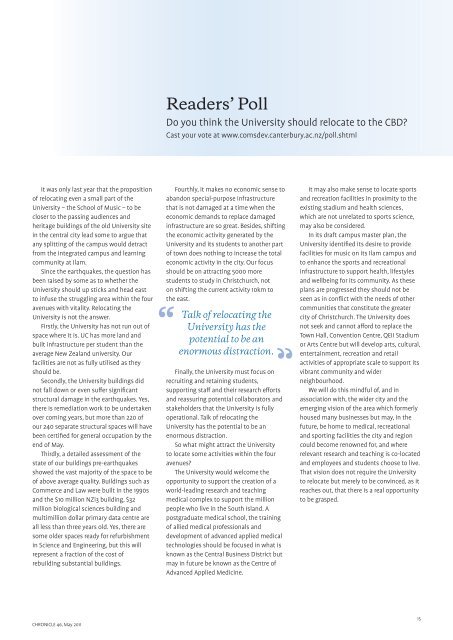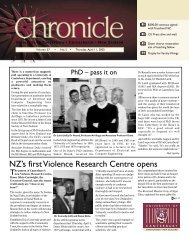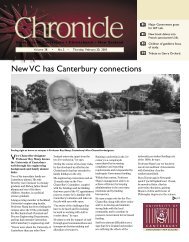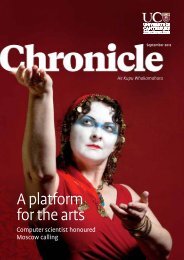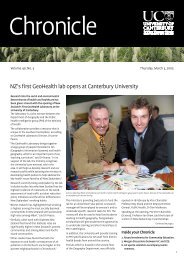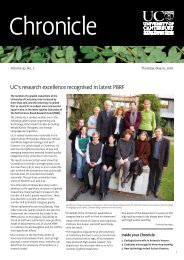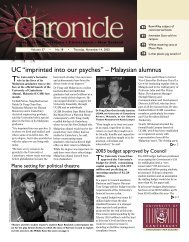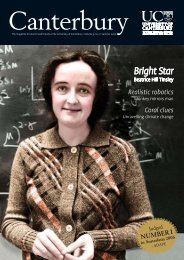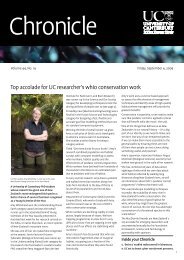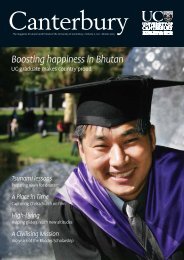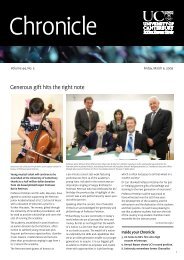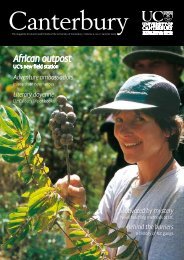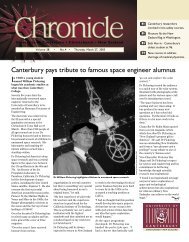Chronicle - Communications - University of Canterbury
Chronicle - Communications - University of Canterbury
Chronicle - Communications - University of Canterbury
Create successful ePaper yourself
Turn your PDF publications into a flip-book with our unique Google optimized e-Paper software.
Readers’ PollDo you think the <strong>University</strong> should relocate to the CBD?Cast your vote at www.comsdev.canterbury.ac.nz/poll.shtmlIt was only last year that the proposition<strong>of</strong> relocating even a small part <strong>of</strong> the<strong>University</strong> – the School <strong>of</strong> Music – to becloser to the passing audiences andheritage buildings <strong>of</strong> the old <strong>University</strong> sitein the central city lead some to argue thatany splitting <strong>of</strong> the campus would detractfrom the integrated campus and learningcommunity at Ilam.Since the earthquakes, the question hasbeen raised by some as to whether the<strong>University</strong> should up sticks and head eastto infuse the struggling area within the fouravenues with vitality. Relocating the<strong>University</strong> is not the answer.Firstly, the <strong>University</strong> has not run out <strong>of</strong>space where it is. UC has more land andbuilt infrastructure per student than theaverage New Zealand university. Ourfacilities are not as fully utilised as theyshould be.Secondly, the <strong>University</strong> buildings didnot fall down or even suffer significantstructural damage in the earthquakes. Yes,there is remediation work to be undertakenover coming years, but more than 220 <strong>of</strong>our 240 separate structural spaces will havebeen certified for general occupation by theend <strong>of</strong> May.Thirdly, a detailed assessment <strong>of</strong> thestate <strong>of</strong> our buildings pre-earthquakesshowed the vast majority <strong>of</strong> the space to be<strong>of</strong> above average quality. Buildings such asCommerce and Law were built in the 1990sand the $10 million NZi3 building, $32million biological sciences building andmultimillion dollar primary data centre areall less than three years old. Yes, there aresome older spaces ready for refurbishmentin Science and Engineering, but this willrepresent a fraction <strong>of</strong> the cost <strong>of</strong>rebuilding substantial buildings.Fourthly, it makes no economic sense toabandon special-purpose infrastructurethat is not damaged at a time when theeconomic demands to replace damagedinfrastructure are so great. Besides, shiftingthe economic activity generated by the<strong>University</strong> and its students to another part<strong>of</strong> town does nothing to increase the totaleconomic activity in the city. Our focusshould be on attracting 5000 morestudents to study in Christchurch, noton shifting the current activity 10km tothe east.“Talk <strong>of</strong> relocating the<strong>University</strong> has thepotential to be anenormous distraction.Finally, the <strong>University</strong> must focus onrecruiting and retaining students,supporting staff and their research effortsand reassuring potential collaborators andstakeholders that the <strong>University</strong> is fullyoperational. Talk <strong>of</strong> relocating the<strong>University</strong> has the potential to be anenormous distraction.So what might attract the <strong>University</strong>to locate some activities within the fouravenues?The <strong>University</strong> would welcome theopportunity to support the creation <strong>of</strong> aworld-leading research and teachingmedical complex to support the millionpeople who live in the South Island. Apostgraduate medical school, the training<strong>of</strong> allied medical pr<strong>of</strong>essionals anddevelopment <strong>of</strong> advanced applied medicaltechnologies should be focused in what isknown as the Central Business District butmay in future be known as the Centre <strong>of</strong>Advanced Applied Medicine.“It may also make sense to locate sportsand recreation facilities in proximity to theexisting stadium and health sciences,which are not unrelated to sports science,may also be considered.In its draft campus master plan, the<strong>University</strong> identified its desire to providefacilities for music on its Ilam campus andto enhance the sports and recreationalinfrastructure to support health, lifestylesand wellbeing for its community. As theseplans are progressed they should not beseen as in conflict with the needs <strong>of</strong> othercommunities that constitute the greatercity <strong>of</strong> Christchurch. The <strong>University</strong> doesnot seek and cannot afford to replace theTown Hall, Convention Centre, QEII Stadiumor Arts Centre but will develop arts, cultural,entertainment, recreation and retailactivities <strong>of</strong> appropriate scale to support itsvibrant community and widerneighbourhood.We will do this mindful <strong>of</strong>, and inassociation with, the wider city and theemerging vision <strong>of</strong> the area which formerlyhoused many businesses but may, in thefuture, be home to medical, recreationaland sporting facilities the city and regioncould become renowned for, and whererelevant research and teaching is co-locatedand employees and students choose to live.That vision does not require the <strong>University</strong>to relocate but merely to be convinced, as itreaches out, that there is a real opportunityto be grasped.CHRONICLE 46, May 201115


